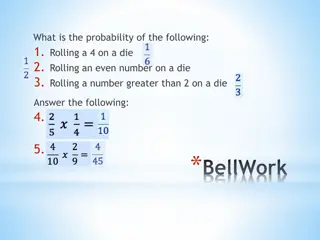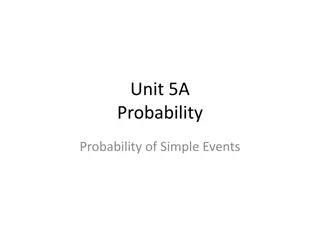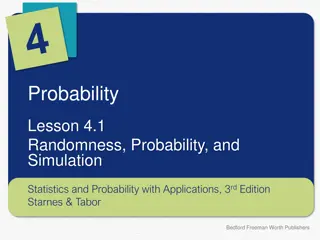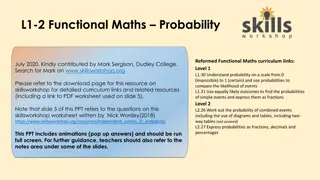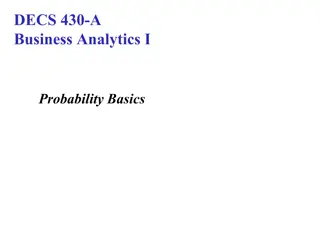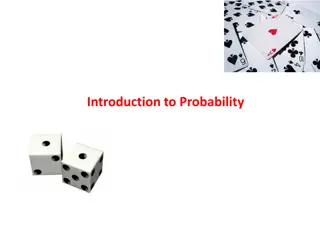Understanding Probability Theory: Basics and Applications
Probability theory is a branch of mathematics that deals with the likelihood of different outcomes in random phenomena. It involves concepts such as sample space, probability distributions, and random variables to determine the chance of events occurring. The theory utilizes theoretical and experimental approaches to study probabilities, defining events, and assessing uncertain situations mathematically. By understanding the basics and formulas of probability theory, one can analyze and predict the likelihood of various outcomes in different scenarios.
Download Presentation

Please find below an Image/Link to download the presentation.
The content on the website is provided AS IS for your information and personal use only. It may not be sold, licensed, or shared on other websites without obtaining consent from the author. Download presentation by click this link. If you encounter any issues during the download, it is possible that the publisher has removed the file from their server.
E N D
Presentation Transcript
THEORY OF PROBABILITY CHAPTER 1
INTRODUCTION Probability theory is a branch of mathematics that investigates the probabilities associated with a random phenomenon. A random phenomenon can have several outcomes. Probability theory describes the chance of occurrence of a particular outcome by using certain formal concepts. Probability theory makes use of some fundamentals such as sample space, probability distributions, random variables, etc. to find the likelihood of occurrence of an event. In this article, we will take a look at the definition, basics, formulas, examples, and applications of probability theory.
Probability theory makes the use of random variables and probability distributions to assess uncertain situations mathematically. In probability theory, the concept of probability is used to assign a numerical description to the likelihood of occurrence of an event. Probability can be defined as the number of favorable outcomes divided by the total number of possible outcomes of an event
PROBABILITY THEORY DEFINITION Probability theory is a field of mathematics and statistics that is concerned with finding the probabilities associated with random events. There are two main approaches available to study probability theory. These are theoretical probability and experimental probability. Theoretical probability is determined on the basis of logical reasoning without conducting experiments. In contrast,experimental probability is determined on the basis of historic data by performing repeated experiments. Probability Theory Example Suppose the probability of obtaining a number 4 on rolling a fair dice needs to be established. The number of favorable outcomes is 1. The possible outcomes of the dice are {1, 2, 3, 4, 5, 6}. This implies that there are a total of 6 outcomes. Thus, the probability of obtaining 4 on a dice roll, using probability theory, can be computed as 1 / 6 = 0.167.
Probability Theory Basics There are some basic terminologies associated with probability theory that aid in the understanding of this field of mathematics. Random Experiment Probability Theory Basics There are some basic terminologies associated with probability theory that aid in the understanding of this field of mathematics. Random Experiment Sample space can be defined as the set of all possible outcomes that result from conducting a random experiment. For example, the sample space of tossing a fair coin is {heads, tails}. Event Probability theory defines an event as a set of outcomes of an experiment that forms a subset of the sample space. The types of events are given as follows:
Independent events: Events that are not affected by other events are independent events. Dependent events: Events that are affected by other events are known as dependent events. Mutually exclusive events: Events that cannot take place at the same time are mutually exclusive events. Equally likely events: Two or more events that have the same chance of occurring are known as equally likely events. Exhaustive events: An exhaustive event is one that is equal to the sample space of an experiment.
Random Variable In probability theory, a random variable can be defined as a variable that assumes the value of all possible outcomes of an experiment. There are two types of random variables as given below. Discrete Random Variable:Discrete random variables can take an exact countable value such as 0, 1, 2... It can be described by the cumulative distribution function and the probability mass function. Continuous Random Variable: A variable that can take on an infinite number of values is known as a continuous random variable. The cumulative distribution function and probability density function are used to define the characteristics of this variable. Probability Probability, in probability theory, can be defined as the numerical likelihood of occurrence of an event. The probability of an event taking place will always lie between 0 and 1. This is because the number of desired outcomes can never exceed the total number of outcomes of an event. Theoretical probability and empirical probability are used in probability theory to measure the chance of an event taking place.
Probability Theory Formulas There are many formulas in probability theory that help in calculating the various probabilities associated with events. The most important probability theory formulas are listed below. Theoretical probability: Number of favorable outcomes / Number of possible outcomes. Empirical probability: Number of times an event occurs / Total number of trials. Addition Rule: P(A B) = P(A) + P(B) - P(A B), where A and B are events. Complementary Rule: P(A') = 1 - P(A). P(A') denotes the probability of an event not happening. Independent events: P(A B) = P(A) P(B)
Conditional probability: P(A | B) = P(AB) / P(B) Bayes' Theorem: P(A | B) = P(B | A) P(A) / P(B) Probability mass function: f(x) = P(X = x) Probability density function: p(x) = p(x) = dF(x)dxdF(x)dx = F'(x), where F(x) is the cumulative distribution function. Expectation of a continuous random variable: xf(x)dx xf(x)dx, where f(x) is the pdf. Expectation of a discrete random variable: xp(x) xp(x), where p(x) is the pmf. Variance: Var(X) = E[X2] - (E[X])2
Applications of Probability Theory Probability theory is used in every field to assess the risk associated with a particular decision. Some of the important applications of probability theory are listed below: In the finance industry, probability theory is used to create mathematical models of the stock market to predict future trends. This helps investors to invest in the least risky asset which gives the best returns. The consumer industry uses probability theory to reduce the probability of failure in a product's design. Casinos use probability theory to design a game of chance so as to make profits.





